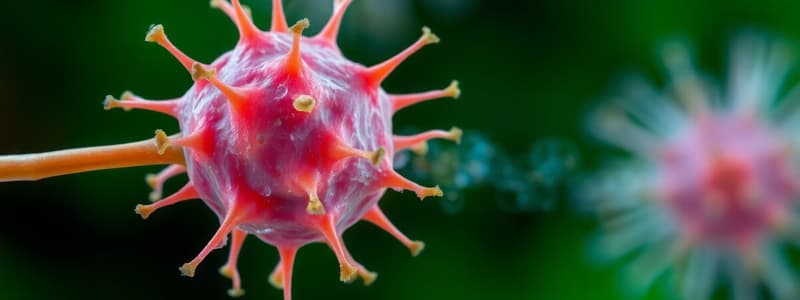Podcast
Questions and Answers
What are cilia on olfactory receptor neurons (ORNs) responsible for?
What are cilia on olfactory receptor neurons (ORNs) responsible for?
- Transmitting signals to the olfactory cortex
- Regulating olfactory adaptation
- Binding odourant molecules (correct)
- Protecting the dendrites from external stimuli
Which statement about olfactory receptors is correct?
Which statement about olfactory receptors is correct?
- Humans have about 300-400 types of functioning olfactory receptors. (correct)
- Dogs possess a higher percentage of pseudogenes in comparison to humans.
- Each olfactory receptor gene codes for multiple types of ORNs.
- Olfactory receptors have a protective barrier similar to other sensory receptors.
What is cross-adaptation in olfaction?
What is cross-adaptation in olfaction?
- Increased sensitivity to distinct odours after continuous exposure.
- Reduced sensitivity to similar odourants after repeating exposure. (correct)
- The ability to identify different odours without context.
- A mechanism that blocks strong odours from being perceived.
Which region is considered the primary olfactory cortex?
Which region is considered the primary olfactory cortex?
How does sex impact olfactory detection thresholds?
How does sex impact olfactory detection thresholds?
At what age does approximately 50% of the population experience effective anosmia?
At what age does approximately 50% of the population experience effective anosmia?
What unique relationship do odours have concerning emotional and memory contexts?
What unique relationship do odours have concerning emotional and memory contexts?
How many olfactory receptor genes do mammals typically have?
How many olfactory receptor genes do mammals typically have?
What is the primary function of olfactory receptor neurons (ORNs)?
What is the primary function of olfactory receptor neurons (ORNs)?
Which statement correctly describes the role of the cribriform plate in olfaction?
Which statement correctly describes the role of the cribriform plate in olfaction?
What are glomeruli in the context of olfactory function?
What are glomeruli in the context of olfactory function?
What occurs in the posterior piriform cortex (PPC) concerning odour recognition?
What occurs in the posterior piriform cortex (PPC) concerning odour recognition?
What is the role of supporting cells in the olfactory epithelium?
What is the role of supporting cells in the olfactory epithelium?
Anosmia is caused by which of the following conditions?
Anosmia is caused by which of the following conditions?
Which type of cell acts as precursor cells to olfactory receptor neurons?
Which type of cell acts as precursor cells to olfactory receptor neurons?
What role does the limbic system play in olfaction?
What role does the limbic system play in olfaction?
What is receptor adaptation in the context of olfaction?
What is receptor adaptation in the context of olfaction?
Which of the following characteristics is required for a molecule to be considered an odourant?
Which of the following characteristics is required for a molecule to be considered an odourant?
Cognitive habituation affects our sense of smell by causing what?
Cognitive habituation affects our sense of smell by causing what?
Which mechanism contributes to cross-adaptation in olfactory perception?
Which mechanism contributes to cross-adaptation in olfactory perception?
How does the sense of smell primarily function as a detector?
How does the sense of smell primarily function as a detector?
What can be a consequence of olfactory receptor internalization during odour adaptation?
What can be a consequence of olfactory receptor internalization during odour adaptation?
Which aspect of the olfactory process is most influenced by genetics?
Which aspect of the olfactory process is most influenced by genetics?
What is the tip-of-the-nose phenomenon?
What is the tip-of-the-nose phenomenon?
What phenomenon describes the reduced sensitivity to odourants that are chemically similar to those a person has repeatedly encountered?
What phenomenon describes the reduced sensitivity to odourants that are chemically similar to those a person has repeatedly encountered?
Humans have a higher percentage of functional olfactory receptor genes compared to dogs and mice.
Humans have a higher percentage of functional olfactory receptor genes compared to dogs and mice.
What percentage of the population is effectively anosmic by age 85?
What percentage of the population is effectively anosmic by age 85?
The __________ cortex is regarded as the main area for olfactory processing in the brain.
The __________ cortex is regarded as the main area for olfactory processing in the brain.
Match the following odour-related professions with their associated skills:
Match the following odour-related professions with their associated skills:
Which factor does NOT significantly affect olfactory detection thresholds?
Which factor does NOT significantly affect olfactory detection thresholds?
Women typically have lower olfactory detection thresholds than men.
Women typically have lower olfactory detection thresholds than men.
What role does the amygdala–hippocampal complex play in olfactory cognition?
What role does the amygdala–hippocampal complex play in olfactory cognition?
Which of the following is NOT a requirement for a molecule to be classified as an odourant?
Which of the following is NOT a requirement for a molecule to be classified as an odourant?
Anosmia can result from a fractured cribriform plate due to head trauma.
Anosmia can result from a fractured cribriform plate due to head trauma.
What is the primary purpose of the nose?
What is the primary purpose of the nose?
The __________ is a bony structure that separates the nose from the brain.
The __________ is a bony structure that separates the nose from the brain.
Match the following types of cells with their function in the olfactory epithelium:
Match the following types of cells with their function in the olfactory epithelium:
Which structure contains spherical conglomerates of incoming axons from olfactory receptor neurons?
Which structure contains spherical conglomerates of incoming axons from olfactory receptor neurons?
The posterior piriform cortex is responsible for identifying the specific quality of an odour.
The posterior piriform cortex is responsible for identifying the specific quality of an odour.
What is the role of olfactory receptor neurons (ORNs) in the olfactory system?
What is the role of olfactory receptor neurons (ORNs) in the olfactory system?
What effect does receptor adaptation have on odor detection?
What effect does receptor adaptation have on odor detection?
Cognitive habituation can lead to an inability to detect familiar smells.
Cognitive habituation can lead to an inability to detect familiar smells.
What primary brain region is involved in olfactory processing?
What primary brain region is involved in olfactory processing?
Continuous exposure to an odorant leads to __________, where receptors stop responding to that odorant.
Continuous exposure to an odorant leads to __________, where receptors stop responding to that odorant.
Match the following concepts with their descriptions:
Match the following concepts with their descriptions:
Which statement best describes the role of olfaction?
Which statement best describes the role of olfaction?
The amygdala is part of the olfactory system but does not play a role in emotional responses.
The amygdala is part of the olfactory system but does not play a role in emotional responses.
What is the term for the inability to name an odourant despite familiarity?
What is the term for the inability to name an odourant despite familiarity?
Flashcards
Odourant
Odourant
Molecule detected by olfactory receptors, triggering a neural signal for smell perception.
Detection Threshold
Detection Threshold
The lowest concentration of an odourant needed for a person to detect it.
Olfactory Epithelium
Olfactory Epithelium
Secretory lining in the nose detecting odourants.
Cribriform Plate
Cribriform Plate
Signup and view all the flashcards
Olfactory Receptor Neurons (ORNs)
Olfactory Receptor Neurons (ORNs)
Signup and view all the flashcards
Anosmia
Anosmia
Signup and view all the flashcards
Glomeruli
Glomeruli
Signup and view all the flashcards
Mitral Cells
Mitral Cells
Signup and view all the flashcards
Olfactory Receptors (ORNs)
Olfactory Receptors (ORNs)
Signup and view all the flashcards
Cilia
Cilia
Signup and view all the flashcards
Cross-Adaptation (Olfaction)
Cross-Adaptation (Olfaction)
Signup and view all the flashcards
Piriform Cortex
Piriform Cortex
Signup and view all the flashcards
Olfactory Detection Thresholds
Olfactory Detection Thresholds
Signup and view all the flashcards
Pseudogenes (Olfactory Receptors)
Pseudogenes (Olfactory Receptors)
Signup and view all the flashcards
Amygdala-Hippocampal Complex
Amygdala-Hippocampal Complex
Signup and view all the flashcards
Olfactory Receptors (ORs)
Olfactory Receptors (ORs)
Signup and view all the flashcards
Durability of smell
Durability of smell
Signup and view all the flashcards
Limbic System's Role in Smell
Limbic System's Role in Smell
Signup and view all the flashcards
Tip-of-the-nose phenomenon
Tip-of-the-nose phenomenon
Signup and view all the flashcards
Smell and Language Difference
Smell and Language Difference
Signup and view all the flashcards
Receptor Adaptation
Receptor Adaptation
Signup and view all the flashcards
Cross-Adaptation
Cross-Adaptation
Signup and view all the flashcards
Cognitive Habituation
Cognitive Habituation
Signup and view all the flashcards
Smell Detection
Smell Detection
Signup and view all the flashcards
What's the function of cilia in ORNs?
What's the function of cilia in ORNs?
Signup and view all the flashcards
How many odorant molecules trigger a signal?
How many odorant molecules trigger a signal?
Signup and view all the flashcards
How does smell differ from other senses?
How does smell differ from other senses?
Signup and view all the flashcards
What is cross-adaptation in olfaction?
What is cross-adaptation in olfaction?
Signup and view all the flashcards
How many olfactory receptor genes do mammals have?
How many olfactory receptor genes do mammals have?
Signup and view all the flashcards
Why are some ORNs non-functional?
Why are some ORNs non-functional?
Signup and view all the flashcards
What's the role of the piriform cortex?
What's the role of the piriform cortex?
Signup and view all the flashcards
What does the Amygdala-hippocampal complex do?
What does the Amygdala-hippocampal complex do?
Signup and view all the flashcards
What makes a molecule an odourant?
What makes a molecule an odourant?
Signup and view all the flashcards
What is the olfactory epithelium?
What is the olfactory epithelium?
Signup and view all the flashcards
What is the cribriform plate?
What is the cribriform plate?
Signup and view all the flashcards
What is anosmia?
What is anosmia?
Signup and view all the flashcards
What is the posterior piriform cortex (PPC)?
What is the posterior piriform cortex (PPC)?
Signup and view all the flashcards
What are the types of cells in the olfactory epithelium?
What are the types of cells in the olfactory epithelium?
Signup and view all the flashcards
What are mitral cells and tufted cells?
What are mitral cells and tufted cells?
Signup and view all the flashcards
What are glomeruli?
What are glomeruli?
Signup and view all the flashcards
Limbic system
Limbic system
Signup and view all the flashcards
Why are there fewer words for smells?
Why are there fewer words for smells?
Signup and view all the flashcards
What makes smell a change detector?
What makes smell a change detector?
Signup and view all the flashcards
Three mechanisms of olfactory adaptation
Three mechanisms of olfactory adaptation
Signup and view all the flashcards
Study Notes
Odour and Odourants
- Odour: A general smell sensation of a particular quality
- Odourant: Molecules that olfactory receptors recognize and respond to, producing neural signals that the brain interprets as different odours
- Chemical compounds, not all chemicals are odourants
- To be smelled, molecules must be volatile, small, and hydrophobic
- Detection threshold: The concentration of an odourant needed for detection
Identifying and Discriminating Odours
- Smell's primary purpose: Filtering, warming, and humidifying inhaled air
- Nose structures: Ridges, olfactory cleft, and olfactory epithelium
- Olfactory cleft: Area of the nose where the main olfactory epithelium is located
- Olfactory epithelium: Secretory mucosa detecting odourants in inhaled air
- Cribriform plate: Bony structure with tiny holes, separating the nose from the brain. Axons from olfactory receptor neurons (ORNs) pass through these holes into the brain.
- Anosmia: Complete inability to smell, often caused by sinus illness or head trauma. Cribriform plate damage can sever olfactory neurons
- Posterior piriform cortex (PPC): Area of the brain that processes the overall quality of an odour.
- Retina of the nose: Three types of cells
- Supporting cells: Provide metabolic and structural support for ORNs
- Basal cells: Precursor cells to ORNs
- Olfactory receptor neurons (ORNs): Main cells in the olfactory epithelium under a layer of mucus
- Supporting structures
- Mitral cells: Projecting output neurons in olfactory bulbs
- Tufted cells: Secondary output neurons in olfactory bulbs
- Glomeruli: Spherical collections of ORN axons
- Turbinates: Nasal cavity bones that help distribute air
Olfactory Receptors and Adaptations
- Cilia: Hair-like protrusions on ORN dendrites; contain receptor sites for odourant molecules
- Olfactory Receptor (OR): Region on cilia where odourant molecules bind; ~8 molecules bind to one receptor to trigger an action potential
- Difference from other sensory cells: No protective barrier between ORNs and the brain, unlike visual or auditory receptors.
- Adaptation to Odours
- Cross-adaptation: Reduced sensitivity to odourants with similar chemical structures or perceived qualities after continuous exposure.
- Neural Code for Odour
- Genome contains ~1000 olfactory receptor genes, each coding for a single type of ORN
- All mammals have a nearly identical set of ~1000 OR genes. Variations in pseudogene frequency exist between species
- Humans have ~300-400 functional OR genes. Significant variation due to different numbers of pseudogenes.
Smell and the Brain
- Pathway from Nose to Brain: Olfactory receptors to olfactory bulbs to the olfactory tract, then the olfactory cortex, amygdala, hypothalamus, and other brain regions
- Olfactory bulbs contain glomeruli where ORN axons synapse with mitral and tufted cells
- Representing Odours in the Brain
- Piriform cortex: Primary olfactory cortex
- Amygdala-hippocampal complex: Processes emotional and associative aspects of smell
- Entorhinal: sensory association projections to hippocampus
Odours, Emotion, Memory, and Environmental Factors
- People vary in their ability to identify odours, even with context
- Detection, discrimination, and recognition rely on many factors like sex, age, general health
- Olfactory detection thresholds vary by sex, are typically lower in women
- Odours influence the limbic system, a region of the brain involved in emotion and memory, strongly
- Tip-of-the-nose phenomenon: Inability to name a familiar odour
- Mechanisms of Odour Adaptation:
- Internalization of olfactory receptors into cell bodies
- Absorption of odourants into the bloodstream
- Cognitive/emotional factors
- Odour habituation: The psychological process of reduced ability to detect an odour after prolonged exposure
- Three mechanisms for habituation
- Attention influences odour detection
- Importance of attention; cannot smell while asleep
- Effects of Odours on Social Behavior
- Pheromones: Chemicals that trigger behavioral or physiological responses in other members of the same species.
- Vomeronasal olfactory system: Detects pheromones; distinct from the main olfactory system
- Humans use HLA detection (differences in immune system genes) in odours as cues to attract mates
Studying That Suits You
Use AI to generate personalized quizzes and flashcards to suit your learning preferences.




